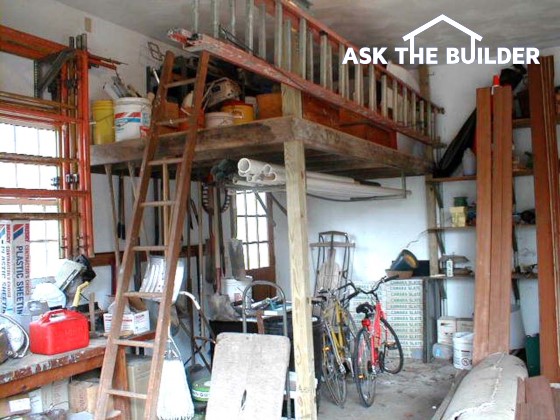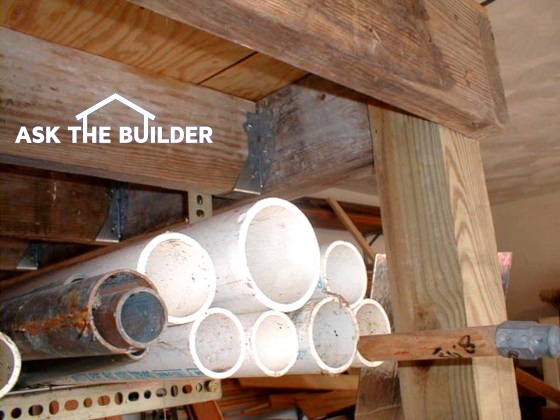A Storage Loft in a Garage

This loft was built in an afternoon. I can easily move around on it.
DEAR TIM: The past owners of our home built, or I should say threw together, a questionable loft on one side of the garage. Thank goodness it hangs over my husband's car and not mine. He is hoping to build a more professional and sturdy loft on my side of the garage and possibly secure or rebuild the one on his side. We just haven't found any plans or directions to guide him. Help us Obiwan the Builder! Mary P., Streamwood, IL
DEAR MARY: The previous owners must have built that loft on the dark side of the garage. It is also possible that they were construction challenged as I tend to call it. In any event, I can help you build a superb garage loft similar to the one at my own home. It does a swell job of capturing all of the flotsam and jetsam that usually drifts from one corner of my garage to the other.
Garage lofts work well because they make use of the void space that exists over the hood of most cars. Typically you can build a 5 or 6 foot deep loft on the back wall of a garage that will not interfere with the windshield of your car. If your garage ceiling height approaches 9 or 10 feet in height, you can end up with hundreds of cubic feet of excellent storage space.
I constructed my loft as I would any exterior deck project. Because my garage ceiling height is 10.5 feet and I am short (5 feet 8 inches ), I was able to construct a loft that I can actually walk beneath. This is a great feature but it is not necessary in all situations. Believe me, the extra space you gain in the loft will more than offset the few times you have to stoop to go under a lower loft.
You begin the project by determining the height of your loft. Using 3/8 or one half inch diameter lag bolts, attach a 2x6 ledger board to the rear wall of the garage. Use a lag bolt at each wall stud and make sure the bolt penetrates at least 2 inches into the wall stud. Do not over tighten as you can strip the wood and create a poor connection.
Place the loft joists at 16 inches on center and have them project out from this ledger at a 90 degree angle. Use standard joist hangers and special heavy duty joist hanger nails for this job. Do not use roofing nails with joist hangers. They are not structural nails and the loft can fall apart if the nail heads pop off or the nail shafts shear off. High quality joist hanger and framing connecting manufacturers make these joist hanger nails. 3/4 inch thick standard sub floor plywood makes a great loft floor. Metal angle irons with holes can be used to construct a nifty pipe storage rack that is suspended beneath the loft.

I used angle irons with holes to make a handy pipe storage rack. It is high enough so I can just walk beneath it.
The opposite end of the floor joists are supported by metal joist hangers that are attached to a beam that runs from one front corner of the loft to the other. This beam may be two 2x6's nailed together or two 2x8's. If your loft width or the spacing between 4x4 posts is greater than 8 feet, I would definitely use the 2x8's. This beam is through bolted to 4x4 posts that run continuously from the floor to the ceiling. Through bolts are ones that have threaded ends and use a nut and a washer to complete the connection. You can purchase very nifty metal post bases that allow you to connect the 4x4 posts to the concrete floor using an expansion anchor that is drilled into the concrete floor. Place the posts so that you will not hit them with your car.
Your existing loft can probably be salvaged. The key items to look at are the type and spacing of the lag bolts used at the wall ledger, the type of nails used with the joist hangers and the size of the beam that supports the front of the loft. Be careful of lofts that are suspended from the ceilings. There is a possibility that the roof structure was not designed for these concentrated loads. That is why I prefer to use 4x4 posts that transfer the loft load to the floor.
Companion Articles: Garage Storage - Loft Material List, Floor Plan for Garage Storage Loft, Garage Storage Loft
Column 265
3 Responses to A Storage Loft in a Garage